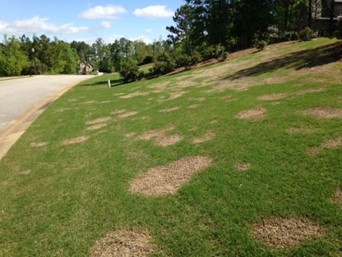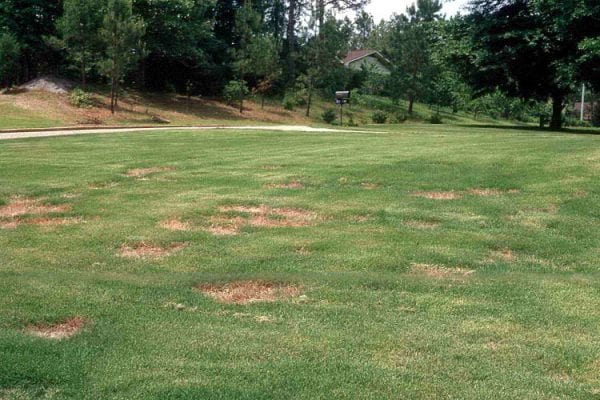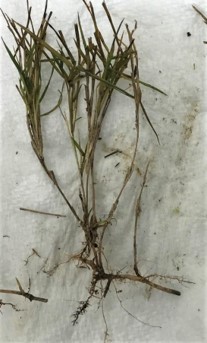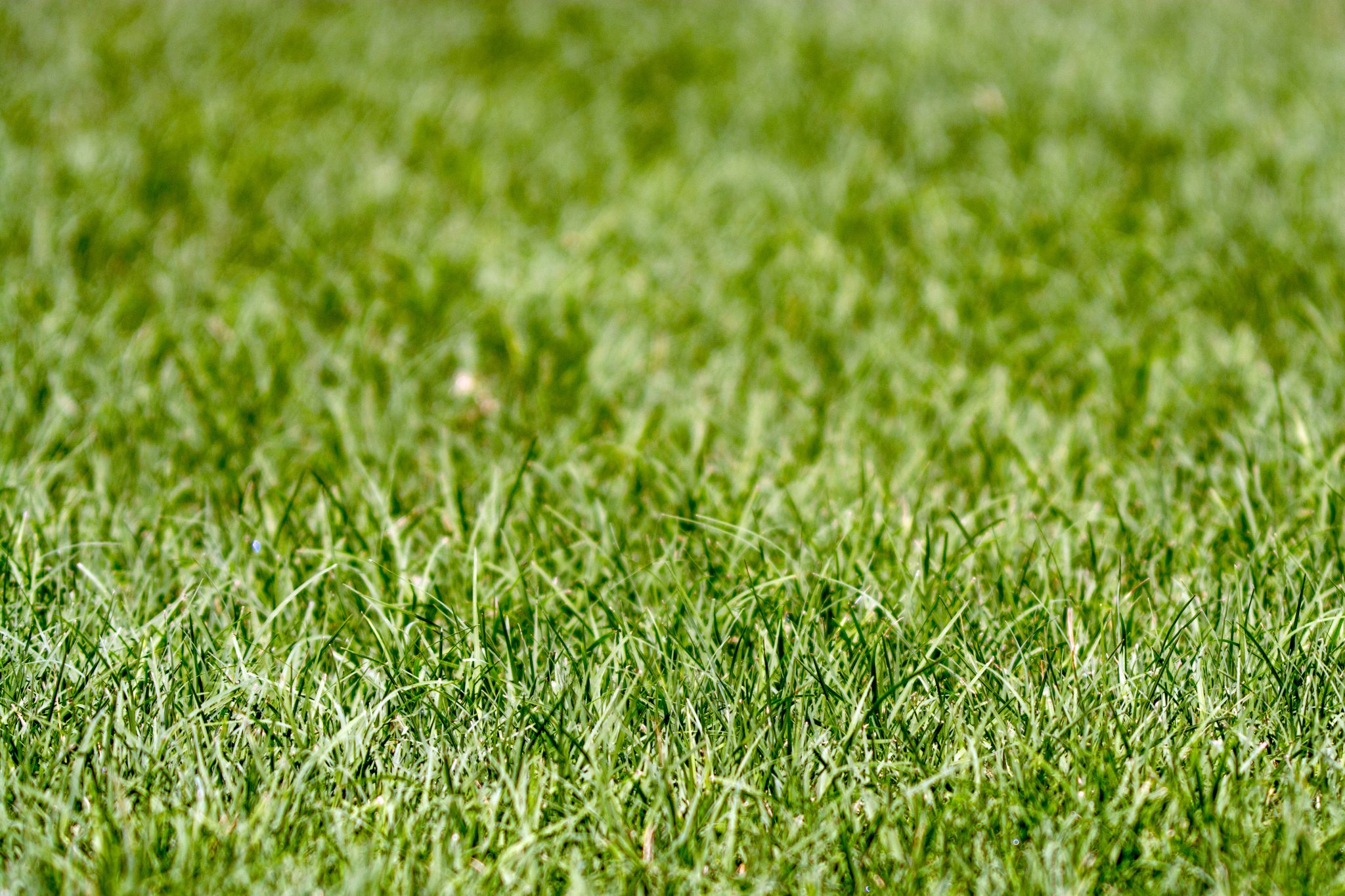Lawn & Garden

These bermudagrass diseases are closely tied to turf management practices. Know how to avoid damage, recognize symptoms, and control disease spread.
Spring dead spot (SDS) is a damaging, often persistent disease of bermudagrass lawns, tees, and greens.
This disease is most common in the northern half of Alabama where adaptation of hybrid bermudagrass cultivars may be marginal. Damage, however, may be seen statewide after an unusually cold winter. A similar patch disease occurs on zoysiagrass. Bermudagrass decline occurs statewide on golf course greens and tees. Development of both diseases is closely tied to turf management practices.
Disease Cause and Occurrence

Figure 1. Sprint dead spot on bermudagrass
SDS occurs most often on intensively managed 3- to 6-year-old turfs. In Alabama, it is caused by an ectotrophic (growing in web on surface) fungus, Ophiosphaerella korrae, commonly associated with this disease. O. korrae has also been linked to an SDS- like patch disease on zoysiagrass. A related fungus, Ophiosphaerella herpotrichia, is a more common causal agent in the midwest. Bermudagrass decline is likely caused by the fungus Gaeumannomyces graminis along with several related fungi.
Excessive nitrogen fertilization, potash deficiency, neutral soil pH, and thatch accumulation increase turf susceptibility to attack by the causal fungus of SDS. Low-maintenance bermudagrass lawns usually have few issues with SDS.
SDS is found on all bermudagrasses but is most damaging on hybrid varieties, particularly ultradwarf bermudagrass selections. Exceptionally low mowing heights, poor drainage, thatch accumulation, and high soil organic matter have been linked with the increased occurrence of bermudagrass decline on greens and tees.
Disease Symptoms

Figure 2. Spring dead spot rings on bermudagrass
On SDS-damaged turf, arc-shaped to circular patches of bleached, dead turf, which range from a few inches to several feet in diameter, appear as the bermudagrass greens up in early spring (figure 1). Patches of diseased turf often appear in the same areas year after year (figure 2). Bermudagrass decline first appears during the summer as irregular patches of yellowed (chlorotic) turf that extend up to several feet in diameter. Extensive stand thinning often develops as the leaves (oldest first) on diseased stolons yellow, wither, and die.
Weeds often invade damaged areas and delay the recovery of diseased turf. Patches of bare ground may be seen on greens badly damaged by bermudagrass decline. Symptoms rarely occur on the higher-cut turf along the collar of a green. Symptoms may resemble those associated with infestations of plant parasitic nematodes or soil fertility or management-related issues.
Roots on stolons collected from turf damaged by SDS and bermudagrass decline are withered, dark brown to black in color, and brittle. Few thick, white, healthy roots are seen on diseased bermudagrass stolons (figure 3).
Recovery of SDS-damaged turf is often slow. The unsightly patches become less noticeable within 2 to 3 months after spring green-up. In drier, cooler areas, the circular patches of dead turf may persist from year to year. Competition from weeds or overseeded grasses will slow the recovery of SDS-damaged turfs. On turfs damaged by bermudagrass decline, some improvement in turf quality may be seen in the fall or early spring, but symptoms rarely disappear.
Disease Control

Figure 3. Discolored roots associated with spring dead spot on bermudagrass
Management practices play a pivotal role in the development of SDS and bermudagrass decline. Practices that promote root growth should help reduce the risk of disease outbreaks and speed recovery of damaged turf.
Fertilizer
Nitrogen sources may have a significant impact on the predisposition of bermudagrass to SDS and bermudagrass decline. Disease development on zoysiagrass also may be influenced by nitrogen sources.
In some studies, nitrate nitrogen sources (ammonium nitrate or calcium nitrate) have been shown to
increase the severity of SDS caused by O. korrae and related ectotrophic fungi on warm- and cool-season turfgrasses. Conversely, acidifying nitrogen sources (ammonium sulfate or ammonium chloride) have been shown to reduce SDS severity, delay the appearance of symptoms, and promote the recovery of diseased turf. Acidifying nitrogen sources are the preferred nitrogen sources for intensively managed, high-risk bermudagrass and zoysiagrass turfs. Excessive use of sulfur-containing fertilizers can delay spring green-up in intensively managed bermudagrass.
To further reduce the risk of disease, fertilize with nitrogen lightly but frequently to maintain moderate turf growth throughout the growing season. Continued use of slow-release forms of organic or inorganic fertilizers also may reduce the risk of SDS and similar patch diseases.
After September 1, avoid applying high rates of any fertilizer containing a fast-release form of nitrogen, such as ammonium nitrate, ammonium sulfate, and similar fast-release nitrogen fertilizers. Fall fertilization with fast- release forms of nitrogen has been shown to increase SDS severity on bermudagrass previously damaged by this disease.
Apply nitrogen and potash (potassium) in a 1:1 to 2:1 ratio. Make a fall application of potash at a rate of 2 pounds of murate of potash (K2O) per 1,000 square feet of turf on greens, tees, and other intensively managed turfs. Use the chloride (murate of potash) rather than the sulfate form of potassium, particularly on turfs previously damaged by SDS or bermudagrass decline.
Maintain phosphorus levels according to soil test recommendations. A near-neutral to slightly alkaline soil pH has been linked to the increased severity of patch- type diseases on bentgrass and may increase severity of SDS on bermudagrass.
Maintain soil pH at 5.8 to 6.2. Before liming, verticut or aerify SDS-damaged turf. When aerifying SDS- damaged turf, take special care to wash and sanitize equipment to prevent accidental spread of the causal fungus to healthy turf. Rather than applying high rates of lime every few years, lime lightly each year to maintain a recommended soil pH on high-risk turfs. Use acid-forming fertilizers on sites with near-neutral to alkaline (7.0+) pH. Apply iron, manganese, and other micronutrients as needed at monthly intervals, and apply gypsum periodically on turf damaged by SDS and bermudagrass decline.
When combined with other recommended management practices, once- or twice-yearly core aerification, verticutting, or other intense surface cultivation methods to facilitate thatch removal will stimulate rooting and may help suppress disease development. Maintaining recommended mowing heights will also promote root growth and reduce symptom severity. See “Home Lawn Maintenance” (Extension publication ANR-0239) for more information on maintaining and fertilizing bermudagrass and zoysiagrass lawns.
Fungicides
The effectiveness of fungicides for controlling SDS has been erratic, which may be related to product performance, application timing, or distribution into the root zone. Fungicides give the best control of SDS when used in combination with recommended maintenance practices over multiple years
Consider preventive fungicide treatments in the fall on greens, tees, and other highly visible, intensively managed turfs. On fairways and most lawns, spot treat only SDS-damaged areas with a recommended fungicide. In areas targeted for fall treatment, prepare a map of SDS or bermudagrass decline damage after you first saw symptoms in the previous spring.
A single fungicide application often proves as effective as a two-application program. Recommended fungicides are listed in table 1 and in “Disease and Nematode Control Recommendations for Commercial Turf and Lawns” (Extension publication IPM-1291).
Table 1. Fungicides for Control of SDS and Bermudagrass Decline
| Commercial Fungicide | Rate 1,000 ft2 | Comments |
|---|---|---|
| azoxystrobin | ||
| HERITAGE TL | 2 fl. oz. | Make 1 or 2 applications in fall or when conditions favor disease. Reapply at 28 days as needed. |
| azoxystrobin +propiconazole | ||
| HEADWAY | 3 fl. oz. | Make 1 or 2 applications in late summer or early fall to previously damaged turf. Reapply after 14 to 28 days in 2 to 4 gallons of water per 1,000 ft2 of treated turf. |
| isofetamid | ||
| KABUTO | 0.5 to 3.2 fl. oz. | Apply a single preventive spray at 3.2 fl. oz. or 2 applications at 0.5 to 2 fl. oz. (spray 1) followed by 0.5 to 1.2 fl. oz. (spray 2) 14 to 28 days later. Applications should begin 1 month prior to dormancy or when soil temperatures drop to 65°F. Apply in 2 gallons of water per 1,000 ft2 and irrigate the day following an application with 1/8-inch water. DO NOT use on residential lawns. |
| isofetamid +tebuconazole | ||
| TEKKEN | 3 fl. oz. | Apply preventively when conditions favor disease development. Apply at 14-day intervals with high disease pressure. Apply at 21- to 28-day intervals when disease pressure is low. Alternate applications of other fungicides with different modes of action (nongroup 3 and 7 fungicides). Apply in 2 gallons of water per 1,000 ft2 and irrigate the day following an application with 1/8-inch water. DO NOT use on residential lawns. |
| mefentrifluconazole | ||
| MAXTIMA | 0.6 to 0.8 fl. oz. 0.8 fl. oz. | For disease control in nonresidential areas: For SDS control, make 2 applications in fall at 70°F soil temperature or 1 application followed by a fungicide combination product containing fluxapyroxad and pyraclostrobin. For control of bermudagrass decline, make 2 applications in the fall and 2 applications in the spring at 28-day intervals. |
| penthiopyrad | ||
| VELISTA | 0.5 to 0.7 oz. | Make 2 applications on a 28-day interval prior to winter dormancy. Do not apply more than 2.2 oz. of product per 1,000 ft2 per year. Approved for use on golf courses; residential, institutional, commercial, and municipal lawns, parks, and recreation areas; and sod farms. |
| tebuconazole | ||
| CLEARSCAPE ETQ MIRAGE TORQUE | 0.6 fl. oz. 0.6 fl. oz. 0.6 fl. oz. | Golf course turf: Apply in 1 to 3 gallons of water per 1,000 ft2 of turf when conditions favor disease and before symptoms are observed. May be reapplied after 21 days as needed. Alternate with other nongroup 3 triazole fungicides containing a fungicide with a different mode of action. |
| propiconazole + lamda-cyhalothrin | ||
| IMMUNOX FUNGUS PLUS INSECT CONTROL FOR LAWNS | 12.8 fl. oz | Make 1 application to area of lawn previously damaged by SDS or zoysia patch in August and a second application approximately 1 month later. One 32-fluid-ounce container with a hose sprayer will treat 2,500 square feet of lawn. Product contains an insecticide to control insect pests in home lawns. See label for further directions along with a list of pests and diseases controlled. |
Austin K. Hagan, Professor Emeritus, Home Grounds, Gardens, and Home Pests; Amanda Strayer-Scherer, Extension Plant Pathologist, Agronomic Crops; James Jacobi, Extension Specialist, Home Grounds, Gardens, and Home Pests; and Lucy Edwards, Regional Extension Agent, Home Grounds, Gardens, and Home Pests, all with Auburn University.
Reviewed September 2022, Control of Spring Dead Spot and Bermudagrass Decline, ANR-0371

